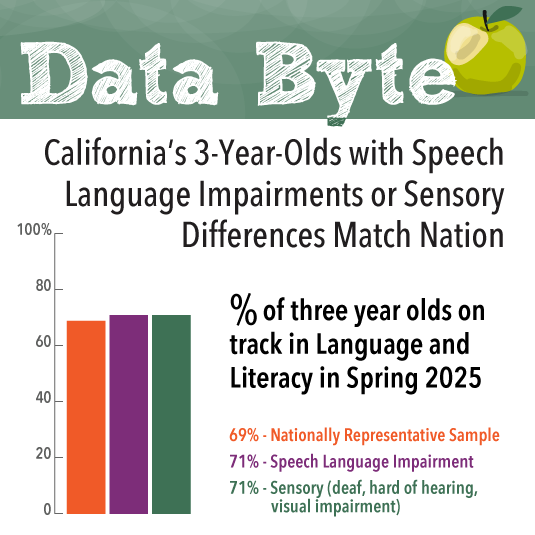 In Spring 2025, California 3-year-olds with speech language impairments and those with sensory differences (deaf, hard of hearing, or visually impaired) were on track in Language and Literacy at rates comparable to a nationally representative sample of all 3-year-olds.
In Spring 2025, California 3-year-olds with speech language impairments and those with sensory differences (deaf, hard of hearing, or visually impaired) were on track in Language and Literacy at rates comparable to a nationally representative sample of all 3-year-olds.
Policy and Research
Policy and Research Section Intro
Data Bytes | Policy | Research
The Desired Results Developmental Profile [DRDP (2015)] is designed to assist the California Department of Education in determining the effectiveness of its early care and education programs. CDE's Special Education Division (SED) implements the DRDP (2015) in Special Education Local Plan Areas (SELPAs) to comply with the Individuals with Disabilities Education Improvement Act of 2004 (IDEA 2004) and requirements of the U.S. Department of Education’s Office of Special Education Programs (OSEP). The Desired Results Access Project conducts research, technical studies, and evaluation activities to support the use of the DRDP (2015) for special education.
Data Bytes
Data Byte: CA's 3-Year-Olds with Speech Language Impairments Match Nation
Data Byte: A more complete picture of early learning progress
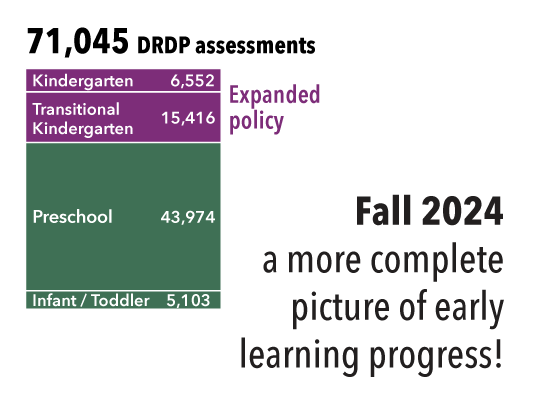 With the inclusion of Transitional Kindergarten and Kindergarten, DRDP submissions now represent a more complete picture of early learning progress!
With the inclusion of Transitional Kindergarten and Kindergarten, DRDP submissions now represent a more complete picture of early learning progress!
The Fall 2024 DRDP policy expansion now requires assessments for all children ages 3–5 with IEPs in Preschool, TK, and K, leading to a significant increase in DRDP submissions.
Data Byte: Language Outcomes for Deaf/Hard of Hearing Children
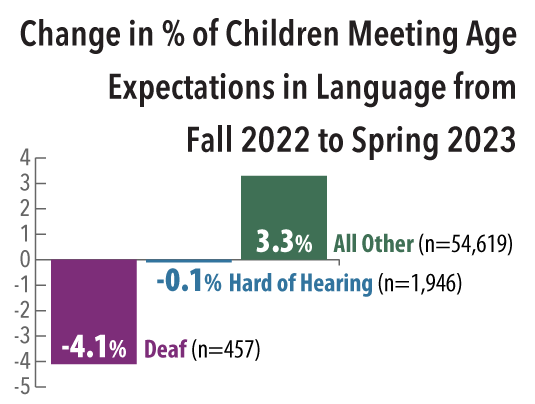 There is an urgent need to support language rich environments for young deaf and hard of hearing children who are falling behind in language. The percentage of deaf children birth through five meeting age expectations decreased by 4 percentage points from fall to spring, a pattern indicative of falling farther behind on language benchmarks.
There is an urgent need to support language rich environments for young deaf and hard of hearing children who are falling behind in language. The percentage of deaf children birth through five meeting age expectations decreased by 4 percentage points from fall to spring, a pattern indicative of falling farther behind on language benchmarks.
Data Byte: California preschool special education services meet state target
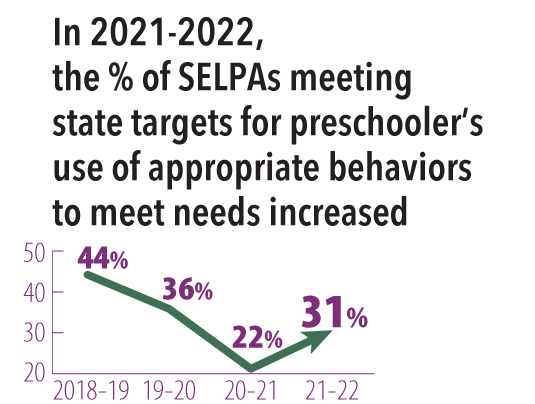 As part of child outcomes reporting, the DR Access Project annually calculates the percent of preschoolers exiting preschool special education functioning at age expectations in “Use of Appropriate Behaviors to Meet Needs”*.
As part of child outcomes reporting, the DR Access Project annually calculates the percent of preschoolers exiting preschool special education functioning at age expectations in “Use of Appropriate Behaviors to Meet Needs”*.
Data Byte: How Has COVID-19 Impacted the Social-Emotional Development of Children?
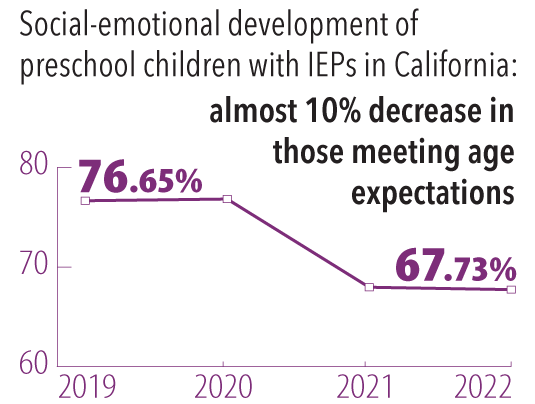 Across the country we are seeing impacts on the social-emotional development of young children due to COVID. National experts explain that these impacts are the result of exacerbated adverse childhood experiences, limited opportunities for social interaction, and reduced enrollment in Pre-K and early intervention services.
Across the country we are seeing impacts on the social-emotional development of young children due to COVID. National experts explain that these impacts are the result of exacerbated adverse childhood experiences, limited opportunities for social interaction, and reduced enrollment in Pre-K and early intervention services.
Policy
Special Education Administrators' Responsibilities for the DRDP
Outlines the responsibilities of SELPA staff and special education administrators for the DRDP.
DRDP Implementation in TK and K: Expanded Requirements for Fall 2024
DRDP requirements are expanding this fall to include any child enrolled in preschool, TK, and K who is 3, 4, or 5-years old. Policy details in this document.
The DRDP (2015) and Federal Requirements for Early Intervention and Preschool Special Education
Describes the requirements of Public Law 108-446, (IDEA 2004) and the U.S. Department of Education's Office of Special Education Programs (OSEP) that form the legal basis for the participation of infants and toddlers and their families with Individualized Family Service Plans (IFSPs) and preschool-age children with Individualized Education Programs (IEPs) in the DRDP (2015). The DRDP (2015) enables California to comply with these federal laws.
SPP Indicator 7 - Linking the DRDP to Federal Child Outcomes
The California Department of Education/Special Education Division uses DRDP data for the State Performance Plan/Annual Performance Report (SPP/APR) to meet requirements of the federal Office of Special Education Programs (OSEP). This document describes the relationship between the DRDP and Indicator 7 of the SPP/APR: Preschool Outcomes.
Alignment of the State Performance Plan Child Outcomes and the DRDP (2015) Measures
A document illustrating how the Domains and Measures of the DRDP (2015) used in early childhood special education correspond to the three OSEP outcomes.
Senate Bill 210 Report
Senate Bill 210 requires the California Department of Education (CDE) to assess the language and literacy development of children, birth to five years of age, identified as deaf and hard of hearing and to annually report their progress. The CDE publishes the SB 210 report annually on its website.
Research
2017-2018 Differential Item Functioning (DIF) Analyses Report
DIF analysis is used to investigate whether measures on an assessment instrument functions differently for different groups of children. Examination of DIF is important to determine whether subgroups of children who possess comparable ability levels have equal (or different) likelihood of receiving the same ratings on the measures. This analysis provides evidence that the DRDP (2015) generally functions as intended for all children of the same ability level (i.e., no bias in a specific developmental area or skill). The two subgroups examined are children with disabilities (infants and toddlers with IFSPs and preschool children with IEPs) and children without disabilities.
Technical Report for the Desired Results Developmental Profile (2015)
This report outlines the technical properties of the Desired Results Developmental Profile (2015) which stem from the specifications that guided the development of the DRDP (2015) to produce a statewide early childhood assessment. The criteria for a high-quality early childhood assessment are presented within 10 indicators along with evidence for how the DRDP (2015) meets each criteria.
2014-15 Interrater Agreement Study Report
This document describes the findings of the 2014-15 Interrater Agreement Study conducted by the Desired Results Access Project. The study investigated rating agreements between pairs of special education assessors who independently rated the DRDP (2015) for the same child within the same time period.
Training Report Fall 2018
In August 2018, the California Department of Education, Special Education Division began requiring that all special education DRDP (2015) assessors complete a training program to increase the accuracy of the DRDP (2015) data. This report describes the results of the first six months of this new training requirement.
